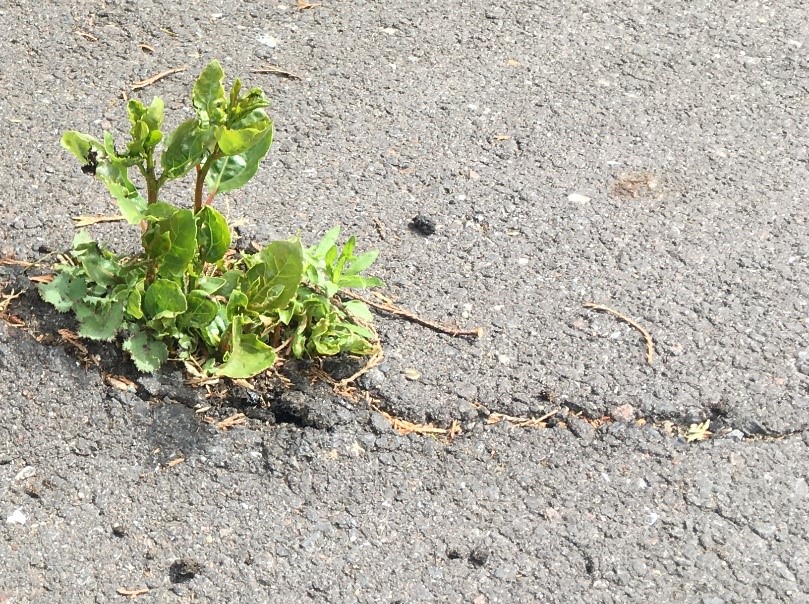 Plant Biology
Plant Biology
How a type of expanding thread dictates plant growth
Until recently, scientists thought that the growth of plant cells is driven by pressure on their rigid cell walls. Using new nanoimaging technology we show that the cell wall polymer pectin can independently expand plant cells. Similar biochemical 'self-expansion' of extracellular polymers in different kingdoms may change our vision of life beyond the plasma membrane.

Have you ever wondered how plants can raise road surfaces and crack concrete? Unraveling this enigma requires understanding how plants grow and generate their shapes. Surprisingly, this simple question is still an open mystery.
In all multicellular organisms, the space between adjacent cells is made up of a matrix containing polysaccharides or fibrous proteins. In plants, cells are surrounded and connected by a cell wall, an intricate network of sugar polymers (or polysaccharides, such as cellulose and pectin) with a pinch of proteins. Until recently, scientists thought cellulose acts as the principal load bearing construction unit within the cell wall, implanted in a gel-like matrix containing pectin. This can be compared to building construction, with iron beams (cellulose) embedded in concrete (pectin). However, our buildings do not grow as plants do. How would you expand a room from within without removing the roof?
The surface of a plant cell balances two opposing forces: the rigid structure of the cell wall, versus the pressure of the water contained inside the cell, called turgor pressure. Until recently, scientists thought that turgor pressure is the force that drives plant cell expansion. Interestingly, turgor puts equal pressure in the cell wall in all directions, which raises the question: why are not all plant cells round? Loosening the cell wall in a specific location allows the cell to expand in that direction. This is similar to an old balloon expanding faster in the thinner parts. Furthermore, the orientation of the cellulose fibers is a key factor in the direction on cell growth, and indeed, disrupting the structure of the cellulose scaffolding leads to cell growing equally in all directions.
Using novel techniques in nanoimaging and cryogenic electron microscope, we revealed a puzzling aspect of plant cell wall, which may alter our understanding of plant growth. The super-resolution microscope, a technology awarded the Nobel Prize in Chemistry in 2014, allowed us to acquire the first highly-detailed images of pectin in an intact cell wall. These revealed that pectin does not form a jelly as previously thought, but much like cellulose aligned threads of polymers. These threads expand radially when they are chemically modified, and their orientation can dictate the direction of cell growth
With these results, we show that the cell wall itself is capable of 'self-expansion' even in the absence of turgor. In this way, the cell wall does not only "allow" the cell to expand, but also controls and promotes this expansion actively.
This discovery may have profound implications throughout biology. Bacteria, yeast, and algae all have cell walls, which may employ pectin in similar strategies to determine shape and direction of growth.
Acknowledgements
We thank Dr. Raymond Wightman for his remarks on our article.
Original Article:
Haas KT, Wightman R, Meyerowitz EM, Peaucelle A. Pectin homogalacturonan nanofilament expansion drives morphogenesis in plant epidermal cells. Science. 2020;367(6481):1003-1007.
Next read: How platelets pull the strings by Ingmar Schoen , Sebastian Lickert , Viola Vogel
Edited by:
Dr. Ayala Sela , Associate Editor
We thought you might like
More from Plant Biology
Unravelling the Secrets of Pine Roots: A Tale of Nutrition and Adaptation
Oct 20, 2023 in Plant Biology | 3.5 min read by Rafael Cañas , Francisco OrtigosaStressful memories help plants resist caterpillars
Oct 2, 2023 in Plant Biology | 3.5 min read by Samuel Wilkinson , Adam Hannan Parker , Jurriaan TonDecoding the genome of a jackfruit that grows all year round
Sep 6, 2023 in Plant Biology | 3.5 min read by Tofazzal IslamLife after logging: the tale of recovering tropical forests
Aug 21, 2023 in Plant Biology | 3.5 min read by Maria Mills , Terhi RiuttaEditor's picks
Trending now
Popular topics


